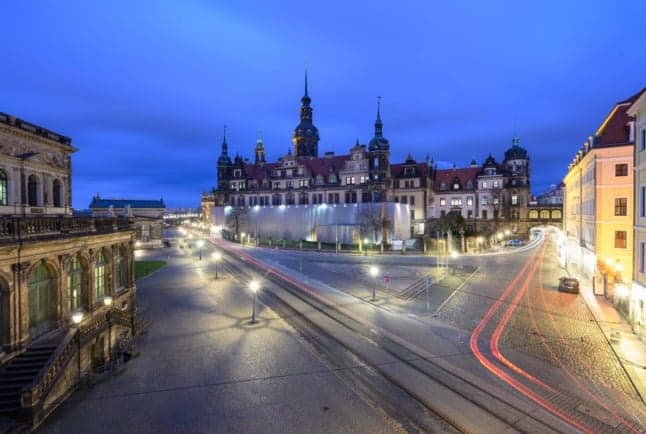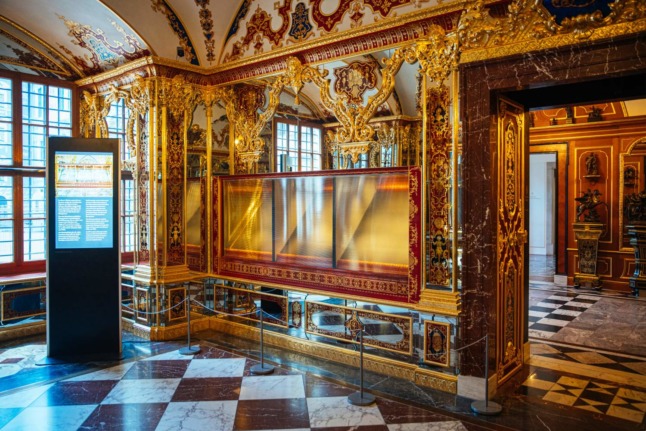Trial opens in spectacular Dresden museum jewel heist

German prosecutors on Friday accused six young members of a notorious criminal family of carrying out a "purposefully prepared" heist on a state museum in Dresden, as a trial opened over the spectacular robbery of priceless 18th-century jewels.
The suspects, aged 22 to 28, are accused of gang robbery and arson after the brazen night raid on the Green Vault museum in Dresden's Royal Palace on November 25th, 2019.
To this day, there is still no trace of the jewels, including a sword with a diamond-encrusted hilt and a shoulderpiece which contains the famous 49-carat Dresden white diamond.
Reading the indictment in court, prosecutor Christian Weber said the suspects had stolen "unique and irreplaceable treasures... of outstanding cultural and historical significance".
One of the suspects covered his face with a grey hooded sweater, while others hid behind files and folders.
While charging the men last year, prosecutors described the museum pieces as "extremely important in terms of art and cultural history".
The robbers took just eight minutes, cutting the power and breaking in through a window with which they had previously tampered.
Two men armed with an axe then stormed into the showroom and stole the jewels before fleeing in a car, which they torched in an underground car park.
The thieves grabbed 21 pieces of jewellery and other valuables from the collection of the Saxon ruler August the Strong, encrusted with more than 4,300 individual diamonds.
Operation Epaulette
Insurance experts say the loot is worth at least €113.8 million ($128 million), with German media dubbing it the biggest art heist in modern history.
However, the director of Dresden's state art collection, Marion Ackermann, had refused to put a value on the stolen items, calling them "priceless".
The stunt also caused around a million euros' worth of damage to the museum and car park.

The robbed display case in the Jewel Room of the Historic Green Vault in the Residence Palace in Dresden. Photo: picture alliance/dpa/dpa-Zentralbild | Oliver Killig
Police combed through CCTV footage to identify the suspects, who are all members of the so-called "Remmo clan", an extended family notorious for ties to organised crime in Germany.
The investigation was codenamed "Epaulette" after the glittering shoulderpiece.
Three of the suspects were arrested after 1,600 police raided 18 Berlin properties in November 2020.
Another two - twin brothers named by police as Mohammed and Abdul Majed Remmo - were on the run for several months, but were caught in December 2020 and May 2021 respectively.
A final suspect was arrested last summer.
READ ALSO: Everything you need to know about the Dresden museum heist
Gold coin
The Remmos were previously implicated in another stunning museum robbery in the heart of Berlin in 2017, when a 100-kilogramme (220-pound) gold coin was stolen.
Two of the suspects on trial for the Dresden heist are still serving out juvenile sentences for involvement in the theft of the gold coin - which has also never been found.
The "Big Maple Leaf", considered the world's second-largest gold coin after the one-tonne Australian Kangaroo, was snatched from Berlin's prestigious Bode Museum.
Investigators in 2020 targeted the Remmo family with the seizure of 77 properties worth a total of 9.3 million euros, charging that they were purchased with the proceeds of various crimes, including a 2014 bank robbery.
The Dresden trial, which is expected to run until October, is being heard in a juvenile court because two of the suspects were minors at the time of the crime.
In addition to the six main suspects, four other men are being investigated on suspicion of aiding and abetting by scoping out the crime scene the previous day.
Founded by Augustus, Elector of Saxony, in 1723, the Green Vault is one of Europe's oldest museums.
After the Royal Palace suffered severe damage in World War Two, the museum remained closed for decades before it was restored and reopened in 2006.
Experts have warned that the chances of recovering the stolen jewels are slim, with the precious stones likely re-cut in the time that has lapsed since the crime.
By Femke COLBORNE
Comments
See Also
The suspects, aged 22 to 28, are accused of gang robbery and arson after the brazen night raid on the Green Vault museum in Dresden's Royal Palace on November 25th, 2019.
To this day, there is still no trace of the jewels, including a sword with a diamond-encrusted hilt and a shoulderpiece which contains the famous 49-carat Dresden white diamond.
Reading the indictment in court, prosecutor Christian Weber said the suspects had stolen "unique and irreplaceable treasures... of outstanding cultural and historical significance".
One of the suspects covered his face with a grey hooded sweater, while others hid behind files and folders.
While charging the men last year, prosecutors described the museum pieces as "extremely important in terms of art and cultural history".
The robbers took just eight minutes, cutting the power and breaking in through a window with which they had previously tampered.
Two men armed with an axe then stormed into the showroom and stole the jewels before fleeing in a car, which they torched in an underground car park.
The thieves grabbed 21 pieces of jewellery and other valuables from the collection of the Saxon ruler August the Strong, encrusted with more than 4,300 individual diamonds.
Operation Epaulette
Insurance experts say the loot is worth at least €113.8 million ($128 million), with German media dubbing it the biggest art heist in modern history.
However, the director of Dresden's state art collection, Marion Ackermann, had refused to put a value on the stolen items, calling them "priceless".
The stunt also caused around a million euros' worth of damage to the museum and car park.

Police combed through CCTV footage to identify the suspects, who are all members of the so-called "Remmo clan", an extended family notorious for ties to organised crime in Germany.
The investigation was codenamed "Epaulette" after the glittering shoulderpiece.
Three of the suspects were arrested after 1,600 police raided 18 Berlin properties in November 2020.
Another two - twin brothers named by police as Mohammed and Abdul Majed Remmo - were on the run for several months, but were caught in December 2020 and May 2021 respectively.
A final suspect was arrested last summer.
READ ALSO: Everything you need to know about the Dresden museum heist
Gold coin
The Remmos were previously implicated in another stunning museum robbery in the heart of Berlin in 2017, when a 100-kilogramme (220-pound) gold coin was stolen.
Two of the suspects on trial for the Dresden heist are still serving out juvenile sentences for involvement in the theft of the gold coin - which has also never been found.
The "Big Maple Leaf", considered the world's second-largest gold coin after the one-tonne Australian Kangaroo, was snatched from Berlin's prestigious Bode Museum.
Investigators in 2020 targeted the Remmo family with the seizure of 77 properties worth a total of 9.3 million euros, charging that they were purchased with the proceeds of various crimes, including a 2014 bank robbery.
The Dresden trial, which is expected to run until October, is being heard in a juvenile court because two of the suspects were minors at the time of the crime.
In addition to the six main suspects, four other men are being investigated on suspicion of aiding and abetting by scoping out the crime scene the previous day.
Founded by Augustus, Elector of Saxony, in 1723, the Green Vault is one of Europe's oldest museums.
After the Royal Palace suffered severe damage in World War Two, the museum remained closed for decades before it was restored and reopened in 2006.
Experts have warned that the chances of recovering the stolen jewels are slim, with the precious stones likely re-cut in the time that has lapsed since the crime.
By Femke COLBORNE
Join the conversation in our comments section below. Share your own views and experience and if you have a question or suggestion for our journalists then email us at [email protected].
Please keep comments civil, constructive and on topic – and make sure to read our terms of use before getting involved.
Please log in here to leave a comment.